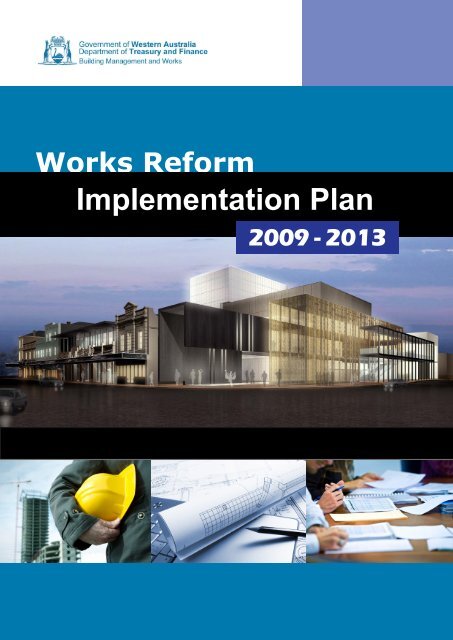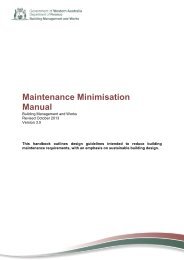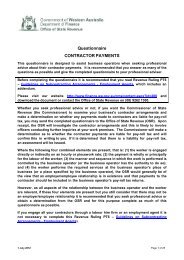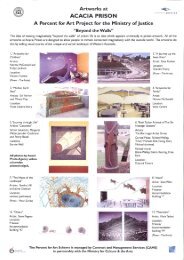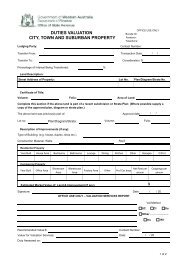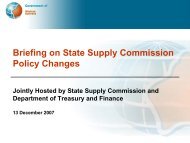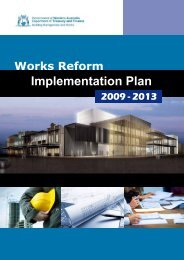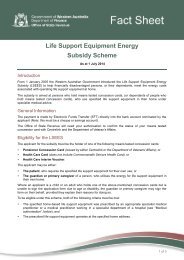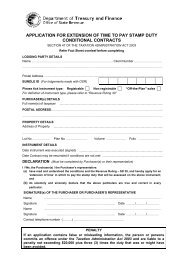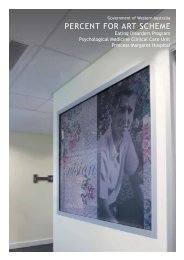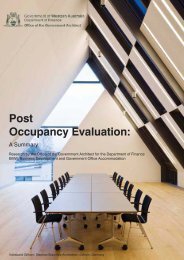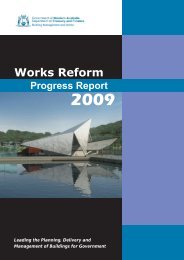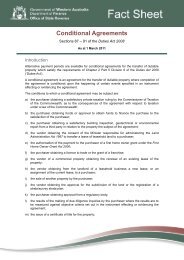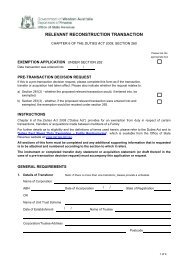Works Reform Implementation Plan - Department of Finance
Works Reform Implementation Plan - Department of Finance
Works Reform Implementation Plan - Department of Finance
Create successful ePaper yourself
Turn your PDF publications into a flip-book with our unique Google optimized e-Paper software.
<strong>Works</strong> <strong>Reform</strong><br />
<strong>Implementation</strong> <strong>Plan</strong><br />
2009 - 2013
© <strong>Department</strong> <strong>of</strong> Treasury and <strong>Finance</strong> March 2010
<strong>Works</strong> <strong>Reform</strong> <strong>Implementation</strong> <strong>Plan</strong> 2009 - 2013<br />
Table <strong>of</strong> Contents<br />
Executive Summary 2<br />
Introduction 10<br />
Balanced Scorecard Approach 12<br />
Program Governance 22<br />
Project Framework 26<br />
Business Change 28<br />
Communications <strong>Plan</strong> 30<br />
<strong>Implementation</strong> Schedule 31<br />
Reporting 32<br />
Appendix 1: Master Balanced Scorecard 33<br />
1
<strong>Works</strong> <strong>Reform</strong> <strong>Implementation</strong> <strong>Plan</strong> 2009 - 2013<br />
Executive Summary<br />
This <strong>Implementation</strong> <strong>Plan</strong> outlines how the Building<br />
Management and <strong>Works</strong> (BMW) business <strong>of</strong> the<br />
<strong>Department</strong> <strong>of</strong> Treasury and <strong>Finance</strong> will implement,<br />
evaluate and report on the <strong>Works</strong> <strong>Reform</strong> program<br />
articulated in the Business Solution <strong>Plan</strong>, released<br />
by the Treasurer in June 2009.<br />
Section 1 provides a brief introduction and<br />
background to the <strong>Works</strong> <strong>Reform</strong> program and its<br />
importance to Government.<br />
Section 2 is the main focus <strong>of</strong> this plan and provides<br />
the detailed approach that has been taken to<br />
realising benefits for the program and the adoption<br />
<strong>of</strong> the Balanced Scorecard framework, which will<br />
be conveyed in an annual <strong>Works</strong> <strong>Reform</strong> program<br />
Benefits Realisation report.<br />
Section 3 <strong>of</strong> the plan details the governance<br />
framework that has been adopted to oversee the<br />
program. BMW has chosen to use the Managing<br />
Successful Programs approach, developed by the<br />
Office <strong>of</strong> Government Commerce in the United<br />
Kingdom as a framework for governance <strong>of</strong> the<br />
<strong>Works</strong> <strong>Reform</strong> program.<br />
The 55 recommendations in the Business Solution<br />
<strong>Plan</strong> have been grouped to form 26 projects,<br />
which will be overseen by four project boards.<br />
The following chart (Figure 1) provides a detailed<br />
breakdown <strong>of</strong> the governance structure, including<br />
the board membership and a matrix outlining the<br />
recommendations contained within the 26 projects<br />
and the Project manager’s allocated.<br />
Section 4 introduces the PRINCE2 project<br />
methodology to support Project Managers in<br />
delivering and reporting on the 26 <strong>Works</strong> <strong>Reform</strong><br />
projects.<br />
Section 5 highlights the change management<br />
principles considered in implementing the <strong>Works</strong><br />
<strong>Reform</strong> program. Both project management and<br />
change management will support BMW move from<br />
a current state (how things are done today), through<br />
a transition state to a desired future state (the new<br />
processes, systems, organisation structures and job<br />
roles defined by ‘the change’).<br />
Section 6 describes the communication and<br />
engagement methods for liaising with a number <strong>of</strong><br />
key stakeholders and outlines the strategies that<br />
will be adopted to ensure an appropriate level <strong>of</strong><br />
consultation is maintained throughout the program.<br />
Section 7 provides the estimated timeframes for the<br />
<strong>Works</strong> <strong>Reform</strong> program, with a commencement date<br />
<strong>of</strong> June 2009, and a projected closeout <strong>of</strong> the formal<br />
program at the end <strong>of</strong> the 2012/13 financial year.<br />
Section 8 outlines the proposed approach to<br />
reporting progress and benefits realised from the<br />
<strong>Works</strong> <strong>Reform</strong> program.<br />
2
<strong>Works</strong> <strong>Reform</strong> <strong>Implementation</strong> <strong>Plan</strong> 2009 - 2013<br />
<strong>Works</strong> <strong>Reform</strong> Program Governance Framework<br />
Sponsors (Treasurer and Under Treasurer)<br />
Program Board<br />
Senior Responsible Owner (J Tondut)<br />
Project Board Chairs Program Manager Business Change Manager<br />
A Kannis, R Mann, J Tondut M Sharpe M Elliot<br />
Project Board 1<br />
Strategic Asset Management<br />
framework and practice<br />
Senior<br />
Users<br />
R Alderton<br />
R Mann<br />
J Tondut<br />
Executive<br />
Sponsor<br />
A Kannis<br />
(Chair)<br />
Senior<br />
Suppliers<br />
S Hackett<br />
D Tyler<br />
S Woodland<br />
Project Board 2<br />
<strong>Plan</strong>ning, delivery and management<br />
<strong>of</strong> buildings for government<br />
Executive<br />
Senior<br />
Users<br />
S Hackett<br />
A Taylor<br />
GM ID (TBA)<br />
Sponsor<br />
R Mann<br />
(Chair)<br />
J Tondut<br />
(Deputy Chair)<br />
Senior<br />
Suppliers<br />
T Budrovich<br />
T Groves<br />
G McLean<br />
K Schmidt<br />
Senior<br />
Users<br />
R Alderton<br />
D Haynes<br />
A Taylor<br />
Project Board 3<br />
BMW Organisation<br />
Executive<br />
Sponsor<br />
J Tondut<br />
(Chair)<br />
Senior<br />
Suppliers<br />
S Jones<br />
P Murray<br />
M Sharpe<br />
Senior<br />
Users<br />
M Intini<br />
M Sharpe<br />
Project Board 4<br />
ICT Systems<br />
Executive<br />
Sponsor<br />
J Tondut<br />
(Chair)<br />
Senior<br />
Suppliers<br />
D Haynes<br />
J Lim<br />
P Murray<br />
<strong>Reform</strong> Facilitator C Ray <strong>Reform</strong> Facilitator S Paul <strong>Reform</strong> Facilitator C Dobb <strong>Reform</strong> Facilitator S Crouchley<br />
Project Project<br />
Manager<br />
Project Project<br />
Manager<br />
Project Project<br />
Manager<br />
Project Project<br />
Manager<br />
A Review & update SAM<br />
framework<br />
P Methven<br />
B Public <strong>Works</strong> Act review M Pearson<br />
C Land Assembly Business<br />
Case<br />
D SAM procedures and<br />
implementation for<br />
non-residential buildings<br />
E Project management and<br />
procurement procedures<br />
for BMW<br />
P Gillies<br />
G McLean<br />
M Pearson<br />
F Design Standards M Payne<br />
Figure 1: <strong>Works</strong> <strong>Reform</strong> Program<br />
Governance Framework<br />
G Supporting Agencies with<br />
Strategic Asset <strong>Plan</strong>s<br />
H Supporting Agencies with<br />
Business Cases<br />
I Portfolio approach to<br />
maintenance<br />
J New procurement<br />
strategies<br />
K Portfolio approach to<br />
Government <strong>of</strong>fice<br />
accommodation<br />
L Funding the BMW<br />
organisation<br />
DJones<br />
G McLean<br />
J Gartner<br />
W Carter<br />
C Bromley<br />
D Haynes<br />
M Heritage Buildings R Smith<br />
N Strategic Projects G McLean<br />
O Regional M Intini<br />
P Organisational Structure D Haynes<br />
Q Skills & Career Paths L Page<br />
R BMW Accommodation P Murray<br />
S Support CEIID P York<br />
T Relationship Management V Willmott<br />
U Industry Training<br />
Business Case<br />
V Building Commission<br />
transition<br />
W <strong>Works</strong> <strong>Reform</strong> Business<br />
Case & Reporting<br />
A Rechichi<br />
D Haynes<br />
M Sharpe<br />
X BMW Transition to<br />
Shared Services<br />
P Birch<br />
Y Core BMW Systems P Murray<br />
Z Whole-<strong>of</strong>-government<br />
asset information<br />
P Murray<br />
3
<strong>Works</strong> <strong>Reform</strong> <strong>Implementation</strong> <strong>Plan</strong> 2009 - 2013<br />
4<br />
Project Board 1 — Strategic Asset Management framework and practice<br />
Project Board Project Project Manager Recommendations<br />
1(a): That the SAM Framework be used at all levels within government and the Treasury<br />
and BMW businesses within the DTF work together to promote and educate all<br />
Government agencies to utilise the SAM Framework.<br />
2: That the DTF reviews the Strategic Asset Management framework to help support the<br />
<strong>Works</strong> <strong>Reform</strong> program.<br />
13: That BMW and Treasury ensure asset disposal options are addressed in the<br />
development <strong>of</strong> strategic asset plans and business cases for capital investment.<br />
14(a): That strategic maintenance planning with a whole-<strong>of</strong>-life cycle view be strengthened<br />
and updated accordingly within the SAM framework, with agencies required to<br />
prepare a 10-year maintenance investment plan.<br />
Project Manager<br />
Treasury<br />
Phillip Methven<br />
A: Review and update<br />
SAM framework<br />
Executive Sponsor<br />
Executive Director<br />
Infrastructure and <strong>Finance</strong><br />
Treasury<br />
Anthony Kannis<br />
(Chair)<br />
Senior Users<br />
41: That a review <strong>of</strong> the Public <strong>Works</strong> Act (1902) be undertaken to clarify legislation on the<br />
procurement <strong>of</strong> works, land, goods and services.<br />
Director Policy and<br />
Practice<br />
Michael Pearson<br />
B: Public <strong>Works</strong> Act<br />
review<br />
Executive Director<br />
Strategic Projects<br />
Richard Mann<br />
44: That BMW prepares a business case for the establishment <strong>of</strong> a Land Assembly unit<br />
to facilitate land acquisition for public buildings in liaison with the <strong>Department</strong> for<br />
<strong>Plan</strong>ning and Infrastructure and the relevant agencies.<br />
Project Development<br />
Manager<br />
Peter Gillies<br />
C: Land Assembly<br />
Business Case<br />
Executive Director<br />
BMW<br />
John Tondut<br />
1(b): That the SAM Framework be used at all levels within government and the Treasury<br />
and BMW businesses within the DTF work together to promote and educate all<br />
Government agencies to utilise the SAM Framework.<br />
3: That the SAM framework be adopted across all functions within BMW as the foundation<br />
<strong>of</strong> the <strong>Works</strong> <strong>Reform</strong> program.<br />
12: That BMW develops guidelines to help integrate whole-<strong>of</strong>-life maintenance thinking<br />
into the planning stage <strong>of</strong> the procurement <strong>of</strong> new buildings.<br />
48: That BMW develops greater skills in the application <strong>of</strong> the SAM framework as it<br />
applies to building assets and adopts the framework as the foundation <strong>of</strong> all policy<br />
and practice processes.<br />
Director Standards and<br />
Practice<br />
Strategic Projects<br />
Graeme Mclean<br />
D: SAM procedures<br />
and implementation<br />
for non-residential<br />
buildings<br />
Executive Director<br />
Government Procurement<br />
Rod Alderton<br />
Senior Suppliers<br />
General Manager<br />
<strong>Plan</strong>ning and Delivery<br />
Steve Hackett<br />
40: That BMW liaises with the DTF Government Procurement business to develop a<br />
common policy suite for all procurement.<br />
49: That BMW develops procedures and guidelines for building works procurement and<br />
project management that establishes best practice standards.<br />
Director Policy and<br />
Practice<br />
Michael Pearson<br />
E: Project management<br />
and procurement<br />
procedures for BMW<br />
Director<br />
Infrastructure <strong>Plan</strong>ning<br />
Treasury<br />
Doug Tyler<br />
47: That BMW engages with the new Government Architect to develop design standards<br />
to meet the objectives <strong>of</strong> government buildings and provide advice and support for<br />
the <strong>Works</strong> <strong>Reform</strong> program.<br />
F: Design Standards Principal Policy Officer<br />
Melinda Payne<br />
Government Architect<br />
Steve Woodland
<strong>Works</strong> <strong>Reform</strong> <strong>Implementation</strong> <strong>Plan</strong> 2009 - 2013<br />
Project Board 2 — <strong>Plan</strong>ning, delivery and management <strong>of</strong> buildings for government<br />
Project Board Project Project Manager Recommendations<br />
4: That DTF works with owner agencies to help prepare their 10-year strategic asset plan,<br />
and then select potential projects for a business case.<br />
14b: That strategic maintenance planning with a whole-<strong>of</strong>-life cycle view be strengthened<br />
and updated accordingly within the SAM Framework, with agencies required to<br />
prepare a 10-year maintenance investment plan.<br />
19: That agencies be required to include a 10-year <strong>of</strong>fice accommodation plan as part <strong>of</strong><br />
their annual capital investment plan.<br />
Principal Project Manager<br />
Asset <strong>Plan</strong>ning<br />
David Jones<br />
G: Supporting<br />
agencies with<br />
Strategic Asset<br />
<strong>Plan</strong>s<br />
Executive Sponsors<br />
Executive Director<br />
Strategic Projects<br />
Richard Mann<br />
(Chair)<br />
Executive Director<br />
BMW<br />
John Tondut<br />
(Deputy Chair)<br />
5: That business cases for new buildings be prepared collaboratively between the owner<br />
agencies and BMW and the final business case jointly signed.<br />
10: That BMW be given a new leadership role in supporting agencies in the development <strong>of</strong><br />
their business cases for maintenance programs on government buildings.<br />
20a: That BMW be given a new leadership role in the development <strong>of</strong> business cases and<br />
<strong>of</strong>fice accommodation programs, using a master planning approach.<br />
50: That BMW becomes a leader in the development <strong>of</strong> business cases, and the application<br />
<strong>of</strong> supporting tools (such as Investment Logic mapping and Value Management).<br />
Director Standards and<br />
Practice<br />
Strategic Projects<br />
Graeme Mclean<br />
H: Supporting<br />
Agencies with<br />
Business Cases<br />
Senior Users<br />
General Manager<br />
<strong>Plan</strong>ning and Delivery<br />
Steve Hackett<br />
I: Portfolio approach<br />
to Maintenance<br />
General Manager<br />
Building Management<br />
Alex Taylor<br />
11. That BMW takes on a whole-<strong>of</strong>-government portfolio management role and provides<br />
advice to Government on how agencies are managing the maintenance <strong>of</strong> their<br />
buildings and property portfolio.<br />
18: That BMW develops a new approach to the planning and funding <strong>of</strong> maintenance and<br />
refurbishment programs for government buildings.<br />
35b: That the current regionally based facilities management role be retained and enhanced,<br />
and the building maintenance planning and procurement strategies integrated into a<br />
State-wide portfolio approach.<br />
Assistant Director<br />
Portfolio <strong>Plan</strong>ning<br />
John Gartner<br />
General Manager<br />
Infrastructure Delivery<br />
Group 1 or 2<br />
TBA<br />
8: That DTF explores new, innovative and non-traditional models <strong>of</strong> procuring new buildings.<br />
15: That BMW explores new, innovative and non-traditional modes <strong>of</strong> procuring building<br />
maintenance services.<br />
16: BMW mandates the use <strong>of</strong> central procurement frameworks for building maintenance.<br />
22b: That BMW strengthens its capability in accommodation planning and procurement.<br />
Director <strong>Plan</strong>ning and<br />
Delivery Group 2<br />
Wayne Carter<br />
J: New procurement<br />
strategies<br />
5
<strong>Works</strong> <strong>Reform</strong> <strong>Implementation</strong> <strong>Plan</strong> 2009 - 2013<br />
6<br />
Project Board 2 (cont’d)<br />
Project Board Project Project Manager Recommendations<br />
23: That BMW reviews the governance <strong>of</strong> the Office Accommodation Advisory Committee<br />
with a view to enhancing consultation and representation.<br />
20b: That BMW be given a new leadership role in the development <strong>of</strong> business cases and<br />
<strong>of</strong>fice accommodation programs using a master planning approach.<br />
21: That BMW reviews existing government <strong>of</strong>fice accommodation policies and develops<br />
a policy suite that aligns with the total portfolio approach.<br />
24a: That BMW reviews the approach to non-<strong>of</strong>fice property leases and develops a more<br />
comprehensive database.<br />
Manager Policy and<br />
<strong>Plan</strong>ning<br />
Claire Bromley<br />
K: Portfolio approach to<br />
Government Office<br />
accommodation<br />
Senior Suppliers<br />
Director <strong>Plan</strong>ning and<br />
Delivery Group 1<br />
Tony Budrovich<br />
Director Maintenance<br />
Services<br />
Tina Groves<br />
7: That BMW be given control over project management <strong>of</strong> all new building procurement<br />
through direct appropriation <strong>of</strong> that part <strong>of</strong> project budgets.<br />
17: That the ‘fee for service’ funding model for BMW maintenance and minor works<br />
services be replaced with direct appropriation.<br />
Director Business<br />
<strong>Plan</strong>ning and Coordination<br />
Darral Haynes<br />
L: Funding the BMW<br />
organisation<br />
Director Standards and<br />
Practice<br />
Strategic Projects<br />
Graeme Mclean<br />
Director Government<br />
Office Accommodation<br />
Karen Schmidt<br />
45b: That BMW, develops an asset register <strong>of</strong> all government building assets with heritage<br />
values, and pursues sustainable management regimes for these buildings.<br />
46: That BMW prepares a business case for the future management <strong>of</strong> Fremantle Prison,<br />
including the appropriate funding model for its ongoing conservation and activation.<br />
M: Heritage Buildings Assistant Director<br />
Heritage Properties<br />
Ross Smith<br />
26: That Strategic Projects continues in its current role and grows its expertise as an<br />
integral part <strong>of</strong> the new BMW business<br />
N: Strategic Projects Director Standards and<br />
Practice<br />
Strategic Projects<br />
Graeme Mclean
<strong>Works</strong> <strong>Reform</strong> <strong>Implementation</strong> <strong>Plan</strong> 2009 - 2013<br />
Project Board 3 — BMW Organisation<br />
Project Board Project Project Manager Recommendations<br />
34: That DTF regional procurement staff from both BMW and Government Procurement<br />
be integrated into four regional teams, with <strong>of</strong>fices located across 13 towns.<br />
35a: That the current regionally based facilities management role be retained and enhanced,<br />
and the building maintenance planning and procurement strategies integrated into a<br />
State-wide portfolio approach.<br />
36: That project management capability be strengthened in regional centres to enable<br />
more regional capital works projects to be managed locally, rather than from Perth,<br />
including temporary relocation for specific projects.<br />
37: That the new BMW regions take on additional responsibilities in <strong>of</strong>fice accommodation<br />
planning and procurement, integrated into the proposed total portfolio approach.<br />
O: Regional Director Regional<br />
Programs<br />
Mino Intini<br />
Executive Sponsor<br />
Executive Director<br />
BMW<br />
John Tondut<br />
(Chair)<br />
Senior Users<br />
Executive Director<br />
Government Procurement<br />
Rod Alderton<br />
9: That the resources within agencies that now undertake new building project<br />
management be re-badged to BMW.<br />
27: That BMW implements a new organisational structure that will grow its leadership and<br />
project management capabilities.<br />
Director Business<br />
<strong>Plan</strong>ning and Coordination<br />
Darral Haynes<br />
P: Organisational<br />
Structure<br />
Director<br />
Business <strong>Plan</strong>ning and<br />
Coordination<br />
Darral Haynes<br />
6: That BMW builds its capability in asset planning, and its expertise in business case<br />
development.<br />
22a: That BMW strengthens its capability in accommodation planning and procurement.<br />
29: That BMW grows its pool <strong>of</strong> highly skilled Project Managers, (as permanent public<br />
servants) to reduce the reliance on consultancies for major infrastructure projects.<br />
30: That a new career path for Project Managers be established – equivalent to the<br />
specified callings arrangements available to other pr<strong>of</strong>essionals – to help attract and<br />
retain staff required to deliver these reforms and ensure a sustainable workforce for<br />
the delivery <strong>of</strong> buildings for Government.<br />
31: That BMW establishes new skills development programs for Project Managers.<br />
Training and<br />
Development Manager<br />
Leanne Page<br />
Q: Skills & Career<br />
Paths<br />
General Manager<br />
Building Management<br />
Alex Taylor<br />
Senior Suppliers<br />
Executive Director<br />
Corporate Services<br />
Sue Jones<br />
28: That BMW accommodates all its existing metropolitan planning and project management<br />
people (apart from any re-badged employees) at one location.<br />
Project Director<br />
Peter Murray<br />
R: BMW<br />
Accommodation<br />
Project Director<br />
Peter Murray<br />
25: That the DTF continues to support the objectives <strong>of</strong> CEIID, actively participating and<br />
working cooperatively to progress its objectives, to share knowledge and deliver<br />
tangible benefits.<br />
S: Support CEIID Assistant Director<br />
CEIID PMO<br />
Peter York<br />
Director<br />
Review and <strong>Reform</strong><br />
Margaret Sharpe<br />
38: That BMW establishes a strong partnership with its key client government agencies<br />
(including a Client Council).<br />
39: That BMW ensures effective liaison is maintained with key building industry associations.<br />
Business Development<br />
and Communications<br />
Manager<br />
Vivien Willmott<br />
T: Relationship<br />
Management<br />
7
<strong>Works</strong> <strong>Reform</strong> <strong>Implementation</strong> <strong>Plan</strong> 2009 - 2013<br />
8<br />
Project Board 3 (cont’d)<br />
Project Board Project Project Manager Recommendations<br />
51: That BMW prepares a business case on the future directions <strong>of</strong> its Industry Training<br />
Program.<br />
Assistant Director<br />
Policy & Practice<br />
Anna Rechichi<br />
U: Industry Training<br />
Business Case<br />
52: That BMW completes the transition <strong>of</strong> its Building Industry Development division to<br />
the <strong>Department</strong> <strong>of</strong> Commerce by 30 June 2009.<br />
Director<br />
Business <strong>Plan</strong>ning &<br />
Coordination<br />
Darral Haynes<br />
V: Building<br />
Commission<br />
transition<br />
53: That BMW now develops an <strong>Implementation</strong> <strong>Plan</strong>, for all the recommendations in the<br />
<strong>Works</strong> <strong>Reform</strong> Business Solution <strong>Plan</strong>.<br />
54: That BMW further develops the business case for the <strong>Works</strong> <strong>Reform</strong>s (including likely<br />
costs and the potential benefits) as part <strong>of</strong> the <strong>Implementation</strong> <strong>Plan</strong>.<br />
55: That BMW undertakes cost and benefit analyses for the four-year <strong>Works</strong> <strong>Reform</strong><br />
program, and provides an annual report to the Treasurer.<br />
Director<br />
Review & <strong>Reform</strong><br />
Margaret Sharpe<br />
W: <strong>Works</strong> <strong>Reform</strong><br />
Business Case &<br />
Reporting
<strong>Works</strong> <strong>Reform</strong> <strong>Implementation</strong> <strong>Plan</strong> 2009 - 2013<br />
Project Board 4 — ICT Systems<br />
Project Board Project Project Manager Recommendations<br />
33: That BMW’s transition to Shared Services be advanced to 2010 (from the current<br />
planned schedule <strong>of</strong> 2012).<br />
Assistant Director<br />
Systems Development<br />
Peter Birch<br />
X: BMW Transition to<br />
Shared Services<br />
Executive Sponsor<br />
32: That BMW develops a business case for systems support required for its new role and<br />
then seeks capital funds to implement the new platforms over the next four years.<br />
Project Director<br />
Peter Murray<br />
Y: Core BMW<br />
Systems<br />
Executive Director<br />
BMW<br />
John Tondut<br />
(Chair)<br />
24b: That BMW reviews the approach to non-<strong>of</strong>fice property leases and develops a more<br />
comprehensive database.<br />
42: That BMW prepares a business case for the development <strong>of</strong> a whole-<strong>of</strong>-government<br />
asset information and management system.<br />
43: That BMW prepares a business case investigating the benefits and costs <strong>of</strong> linking<br />
asset management data with government’s Geographical Information Systems.<br />
45a: That BMW develops an asset register <strong>of</strong> all government building assets with heritage<br />
values, and pursues sustainable management regimes for these buildings.<br />
Project Director<br />
Peter Murray<br />
Z: Whole-<strong>of</strong>government<br />
asset<br />
information<br />
Senior Users<br />
Director<br />
Regional Programs<br />
Mino Intini<br />
Director<br />
Review and <strong>Reform</strong><br />
Margaret Sharpe<br />
Senior Suppliers<br />
Director<br />
Business <strong>Plan</strong>ning and<br />
Coordination<br />
Darral Haynes<br />
Director<br />
Information Management<br />
James Lim<br />
Project Director<br />
Peter Murray<br />
9
<strong>Works</strong> <strong>Reform</strong> <strong>Implementation</strong> <strong>Plan</strong> 2009 - 2013<br />
Introduction<br />
This <strong>Works</strong> <strong>Reform</strong> <strong>Implementation</strong> <strong>Plan</strong> outlines the<br />
approach to implement the recommendations <strong>of</strong> the<br />
Business Solution <strong>Plan</strong>. It also proposes measures<br />
that will enable BMW to evaluate the performance<br />
<strong>of</strong> the <strong>Works</strong> <strong>Reform</strong> program over the coming four<br />
year period.<br />
Government Policy Objectives and<br />
Outcomes<br />
On 15 December 2008, Cabinet approved transferring<br />
the ‘works’ function <strong>of</strong> the former <strong>Department</strong> <strong>of</strong><br />
Housing and <strong>Works</strong> to the <strong>Department</strong> <strong>of</strong> Treasury<br />
and <strong>Finance</strong> (DTF) and the commencement <strong>of</strong><br />
the <strong>Works</strong> <strong>Reform</strong> Program. The BMW business<br />
became operational within the DTF on 1 February<br />
2009.<br />
An extensive review <strong>of</strong> the approach to<br />
non-residential building construction, maintenance<br />
and <strong>of</strong>fice accommodation commenced and on<br />
28 April 2009 Cabinet approved a new lead role and<br />
funding model for BMW.<br />
By the end <strong>of</strong> May, a wide range <strong>of</strong> reform initiatives<br />
had been developed – and on 3 June 2009, the<br />
Treasurer released the <strong>Works</strong> <strong>Reform</strong> Business<br />
Solution <strong>Plan</strong>.<br />
Since then, BMW has developed a mission statement<br />
that shows its responsibilities to Government in<br />
delivering on <strong>Works</strong> <strong>Reform</strong> and highlights its<br />
commitment to this new role.<br />
“To lead the planning, delivery and management<br />
<strong>of</strong> buildings for Government”<br />
The key services for the BMW business have also<br />
been defined as follows:<br />
}}<br />
leads the planning and delivery <strong>of</strong> new<br />
Government buildings;<br />
}}<br />
leads the planning and delivery <strong>of</strong> Government<br />
building maintenance;<br />
}}<br />
leads the planning and delivery <strong>of</strong> Government<br />
<strong>of</strong>fice accommodation;<br />
}}<br />
leads the planning and delivery <strong>of</strong> high risk<br />
infrastructure projects (Strategic Projects); and<br />
}}<br />
facilitates the Centre for Excellence and<br />
Innovation in Infrastructure Delivery (CEIID).<br />
The Business Solution <strong>Plan</strong><br />
The <strong>Works</strong> <strong>Reform</strong> Business Solution <strong>Plan</strong>, released<br />
in June 2009, outlines the proposed reforms to the<br />
planning and delivery <strong>of</strong> new Government buildings;<br />
building maintenance; <strong>of</strong>fice accommodation, and<br />
high risk projects. The plan proposes a change in the<br />
approach to planning and delivery, and will require<br />
a substantial increase in asset planning and project<br />
management capability and capacity within BMW.<br />
BMW Mission Statement<br />
To lead the planning, delivery and management <strong>of</strong><br />
buildings for Government<br />
10
<strong>Works</strong> <strong>Reform</strong> <strong>Implementation</strong> <strong>Plan</strong> 2009 - 2013<br />
The <strong>Works</strong> <strong>Reform</strong> program aims to address the<br />
following key problems with the procurement <strong>of</strong><br />
building related projects and programs:<br />
}}<br />
capital works project cost and time overruns;<br />
}}<br />
poor strategic asset planning across government;<br />
}}<br />
poor business case development for capital<br />
investment;<br />
}}<br />
loss <strong>of</strong> project management skills and experience<br />
within government;<br />
}}<br />
the piecemeal approach to government <strong>of</strong>fice<br />
accommodation;<br />
}}<br />
the piecemeal approach to building maintenance<br />
planning and delivery; and<br />
}}<br />
the overly centralised approach to regional capital<br />
works project management.<br />
The <strong>Works</strong> <strong>Reform</strong> Business Solution <strong>Plan</strong><br />
expands on each <strong>of</strong> these problems and proposes<br />
55 recommendations aimed at implementing the<br />
business solution.<br />
The estimated cost to implement the plan is<br />
summarised in Table 1.<br />
The savings target for the four year program as<br />
outlined in the Business Solution <strong>Plan</strong> is summarised<br />
in Table 2.<br />
2009-2010 2010-2011 2011-2012 2012-2013 Total<br />
Recurrent $6m $8m $10m $10m $34m<br />
Accommodation Fit-out $6m - - - $6m<br />
Information Systems Total <strong>of</strong> $20m over 4 years $20m<br />
Total $60m<br />
Table 1: Indicative costs for the four-year <strong>Works</strong> <strong>Reform</strong> program<br />
SAVINGS 2009-10 2010-11 2011-12 2012-13 Total<br />
In-sourcing Project Management $6m $8m $10m $10m $34m<br />
New Buildings $22m $36m $50m $65m $173m<br />
Breakdown Repairs $4m $6m $8m $10m $28m<br />
Office Accommodation $8m $10m $12m $15m $45m<br />
TOTAL $40m $60m $80m $100m $280m<br />
Table 2: Indicative savings from the four-year <strong>Works</strong> <strong>Reform</strong> program<br />
11
<strong>Works</strong> <strong>Reform</strong> <strong>Implementation</strong> <strong>Plan</strong> 2009 - 2013<br />
Balanced Scorecard Approach<br />
Master Scorecard<br />
To monitor and report on benefits, a Balanced<br />
Scorecard framework will be adopted, the results <strong>of</strong><br />
which will be included in an annual <strong>Works</strong> <strong>Reform</strong><br />
program Benefits Realisation report.<br />
The Balanced Scorecard framework will be used<br />
over a four-year period, to enable BMW to report on<br />
the benefits on a financial year basis.<br />
The Balanced Scorecard is a strategic planning<br />
and management system that is used extensively<br />
in business and government organisations<br />
to align business activities to the vision and<br />
strategy <strong>of</strong> the organisation, improve internal and<br />
external communications, and monitor organisation<br />
performance against strategic goals.<br />
The Balanced Scorecard approach was successful in<br />
measuring performance <strong>of</strong> the Government’s Goods<br />
and Services Procurement <strong>Reform</strong> program, and is<br />
a comprehensive framework for the measurement <strong>of</strong><br />
both financial and non-financial outcomes.<br />
The Balanced Scorecard approach views an<br />
organisation from four perspectives. The grouping<br />
<strong>of</strong> performance measures in perspectives helps the<br />
gathering and selection <strong>of</strong> appropriate performance<br />
indicators or measures.<br />
The four perspectives illustrated in Figure 2 are:<br />
Financial: This refers to financial outcomes, in<br />
particular savings over the four-year program.<br />
Financial measures cover both direct savings<br />
in project outcomes compared with budget, as<br />
well as indirect savings due to BMW efficiency<br />
improvements.<br />
Customer: In BMW’s case, its ultimate client is<br />
the Government, but effective partnerships with<br />
government agencies, who use the buildings are<br />
also essential to achieving the <strong>Works</strong> <strong>Reform</strong><br />
program, as are relationships with industry. This<br />
customer perspective will enable BMW to consider<br />
the importance <strong>of</strong> all <strong>of</strong> its relationships.<br />
Business Processes: This refers to internal business<br />
processes. The foundation business process<br />
for BMW is the Strategic Asset Management<br />
framework. Project Management methodologies are<br />
also fundamental. Metrics based on this perspective<br />
allow the managers to know how well the business<br />
is running, and whether its products and services<br />
conform to customer requirements (the mission).<br />
Learning and Growth: This includes employee<br />
corporate cultural attitudes related to both individual<br />
and corporate self-improvement, as well as measures<br />
in ease <strong>of</strong> communication, technological tools, skills<br />
development, and overall job satisfaction.<br />
12
<strong>Works</strong> <strong>Reform</strong> <strong>Implementation</strong> <strong>Plan</strong> 2009 - 2013<br />
FINANCIAL<br />
Includes financial measures and<br />
covers both direct and indirect<br />
savings from better planning,<br />
delivery and management<br />
<strong>of</strong> buildings for Government.<br />
Measures will also include the<br />
implementation cost <strong>of</strong> the<br />
<strong>Reform</strong> program and the net<br />
benefi t.<br />
BUSINESS PROCESSES<br />
Includes measures that focus<br />
on those processes that the<br />
BMW business must excel at<br />
in order to maximise value<br />
for whole-<strong>of</strong>-government.<br />
Measures address the<br />
effectiveness in delivering<br />
customer requirements.<br />
CUSTOMER<br />
Gathers the view <strong>of</strong> stakeholders,<br />
particularly government<br />
agencies in terms <strong>of</strong> how well<br />
their needs have been met and<br />
the value <strong>of</strong> services provided<br />
in meeting whole-<strong>of</strong>-government<br />
outcomes. These views include<br />
those <strong>of</strong> agency DG’s and senior<br />
operational managers.<br />
LEARNING AND GROWTH<br />
Gathers the views <strong>of</strong> BMW<br />
staff in relation to support,<br />
knowledge, information<br />
systems, developmental<br />
opportunities and job<br />
satisfaction.<br />
For this plan, the Balanced Scorecard has been<br />
developed with a specific purpose in mind –<br />
measuring and reporting on benefits.<br />
Four key steps will be used to develop the Balanced<br />
Scorecard:<br />
Step 1: Identify key goals <strong>of</strong> the <strong>Works</strong> <strong>Reform</strong>;<br />
Step 2: Break down the goals into objectives;<br />
Step 3: Develop a Strategy Map; and<br />
Step 4: Measure, evaluate and report.<br />
The results from this approach are outlined below.<br />
Figure 2: <strong>Works</strong> <strong>Reform</strong> Master Balanced Scorecard<br />
XX<br />
Step 1: Identify the <strong>Works</strong> <strong>Reform</strong> Goals<br />
A goal is the end point. It is what the <strong>Works</strong><br />
<strong>Reform</strong> program is aiming to achieve by the end<br />
<strong>of</strong> the four-year program. A combination <strong>of</strong> BMW’s<br />
Operational Business plan and the <strong>Works</strong> <strong>Reform</strong><br />
Business Solution <strong>Plan</strong> were used as the sources<br />
<strong>of</strong> information for identifying the six key goals <strong>of</strong> the<br />
<strong>Works</strong> <strong>Reform</strong> program, as outlined in Table 3.<br />
Goals<br />
Description<br />
Project Overruns Eliminated<br />
Effective Relationships<br />
Strategic Asset Management<br />
Enabling Systems and Practice<br />
Skilled People<br />
Local Solutions<br />
A fundamental reason for the <strong>Works</strong> <strong>Reform</strong> program is to address the poor<br />
track record <strong>of</strong> project overruns across the non-residential building program.<br />
Effective stakeholder relationships with government agencies and industry<br />
alike that support BMW’s success in strategic asset management and<br />
recognise that government is the ultimate client.<br />
The Strategic Asset Management (SAM) framework drives BMW business<br />
practices, and enhances the planning, delivery and management <strong>of</strong> buildings<br />
for Government.<br />
The development <strong>of</strong> user-friendly tools, standards and practices that enable<br />
better quality decision-making and outcomes.<br />
BMW people are recognised for their skills, knowledge and pr<strong>of</strong>essionalism<br />
in the areas <strong>of</strong> asset management, project management, innovative<br />
procurement and risk management.<br />
An enhanced capability to deliver BMW services from within the country<br />
regions.<br />
Table 3: <strong>Works</strong> <strong>Reform</strong> Goals<br />
13
<strong>Works</strong> <strong>Reform</strong> <strong>Implementation</strong> <strong>Plan</strong> 2009 - 2013<br />
XX<br />
Step 2: Develop the <strong>Works</strong> <strong>Reform</strong> Objectives<br />
Objectives are a crucial element <strong>of</strong> the Balanced<br />
Scorecard. They can be described as the ‘building<br />
blocks’ <strong>of</strong> the six goals. An objective is established<br />
to identify what the program is setting out to achieve<br />
and expressed in measurable terms. The measures<br />
will enable reporting to ensure that all benefits are<br />
aligned to the <strong>Works</strong> <strong>Reform</strong> goals and objectives.<br />
Under the <strong>Works</strong> <strong>Reform</strong> goals, 22 objectives were<br />
developed, as outlined in Table 4, that encompass<br />
the 55 recommendations from the <strong>Works</strong> <strong>Reform</strong><br />
Business Solution <strong>Plan</strong>.<br />
XX<br />
Step 3: Develop the Strategy Map<br />
The next step is to develop the strategy map by<br />
identifying the linkages between the objectives and<br />
placing them in the appropriate Balanced Scorecard<br />
perspective.<br />
As illustrated in Figure 3, improving performance<br />
in the objectives found in the learning and<br />
growth perspective (the bottom row) enables the<br />
organisation to improve its internal processes (the<br />
next row up), which in turn enables the organisation<br />
to create desirable results in the customer and<br />
financial perspectives (the top two rows).<br />
14<br />
Goals<br />
Project Overruns<br />
Eliminated<br />
Effective Relationships<br />
Strategic Asset<br />
Management<br />
Enabling Systems and<br />
Practice<br />
Skilled People<br />
Local Solutions<br />
Objectives<br />
Support service delivery outcomes that deliver value for money.<br />
Establish design standards and quality parameters to meet the value for money<br />
objectives for government buildings.<br />
Deliver well scoped and sound budgets.<br />
Deliver projects on time and within budget.<br />
Treat Government as the ultimate client.<br />
Become a trusted and valued partner with government agencies.<br />
Establish a collaborative relationship with other DTF businesses and works agencies.<br />
Maintain open and effective relationships with suppliers.<br />
Foster effective liaison with local government and industry groups.<br />
Promote and adopt the Strategic Asset Management framework.<br />
Support agencies in the use <strong>of</strong> the Strategic Asset Management framework.<br />
Take a leadership role in managing government’s building assets.<br />
Take a whole-<strong>of</strong>-government long term view to the planning, delivery and<br />
management <strong>of</strong> buildings for government.<br />
Incorporate the Strategic Asset Management framework into Building Management<br />
and Work’s standards and processes.<br />
Strive for innovation in the planning, delivery and management <strong>of</strong> government<br />
buildings.<br />
Develop and implement standard documents, templates and appropriate systems to<br />
support business practices.<br />
Provide transparent, well-informed and timely information.<br />
Grow BMW skills in asset management, project management, procurement, and risk<br />
management.<br />
Attract and retain skilled people.<br />
Enhance roles and capabilities in the country regions to deliver solutions locally.<br />
Align regional processes and practices to central standards.<br />
Support regional development.<br />
Table 4: <strong>Works</strong> <strong>Reform</strong> Objectives
<strong>Works</strong> <strong>Reform</strong> <strong>Implementation</strong> <strong>Plan</strong> 2009 - 2013<br />
FINANCIAL<br />
Improved customer satisfaction, strategic asset management and improved<br />
business processes lead to well planned projects and more efficient and<br />
effective project delivery - on time and within budget.<br />
<br />
<br />
CUSTOMER<br />
Enhanced asset management, project management and<br />
procurement practices and processes lead to delivery <strong>of</strong><br />
service needs and improved customer satisfaction.<br />
<br />
BUSINESS<br />
PROCESS<br />
LEARNING<br />
AND GROWTH<br />
Improved expertise and pr<strong>of</strong>essional skills improve asset management,<br />
project management and procurement practices and processes.<br />
<br />
Investing in the knowledge and skills <strong>of</strong> employees, attracting and<br />
retaining skilled people is the foundation for all innovation and<br />
improvement.<br />
Figure 3: BMW <strong>Works</strong> <strong>Reform</strong> Strategy Map<br />
15
<strong>Works</strong> <strong>Reform</strong> <strong>Implementation</strong> <strong>Plan</strong> 2009 - 2013<br />
Based on the model shown in Figure 3, the objectives are aligned to one <strong>of</strong> the four Balanced Scorecard<br />
perspectives.<br />
Project Overruns Eliminated<br />
FINANCIAL<br />
Support service delivery<br />
outcomes that deliver value<br />
for money<br />
Deliver well scoped and<br />
sound budgets<br />
Establish design standards<br />
and quality parameters<br />
Deliver projects on time and<br />
within budget<br />
<br />
<br />
Effective Relationships<br />
Local Solutions<br />
CUSTOMER<br />
Establish collaborative<br />
relationships with DTF<br />
and works agencies<br />
Treat Government as<br />
the ultimate client<br />
Maintain open and<br />
effective relationships<br />
with suppliers<br />
Become a trusted and<br />
valued partner with<br />
government agencies<br />
Foster effective liaison<br />
with local government<br />
and industry groups<br />
Support regional<br />
development<br />
Align regional practices<br />
and processes to<br />
central standards<br />
<br />
BUSINESS PROCESSES<br />
Strategic Asset Management<br />
Promote and adopt the<br />
SAM framework<br />
Take a leadership role in<br />
managing government’s<br />
buildings assets<br />
Support agencies in the use<br />
<strong>of</strong> the SAM framework<br />
Take a whole-<strong>of</strong>government<br />
long term view<br />
Enabling Systems and Practice<br />
Incorporate SAM into<br />
BMW’s standards and<br />
processes<br />
Develope and implement<br />
standard documents,<br />
templates and systems<br />
Strive for innovation<br />
Provide transparent,<br />
well informed and timely<br />
information<br />
<br />
LEARNING AND GROWTH<br />
Grow BMW skills in planning,<br />
procurement, asset management<br />
and project management<br />
Skilled People<br />
Enhance roles and<br />
capabilities in the regions<br />
Attract and retain skilled<br />
people<br />
16<br />
Figure 4: BMW <strong>Works</strong> <strong>Reform</strong> Strategy Map
<strong>Works</strong> <strong>Reform</strong> <strong>Implementation</strong> <strong>Plan</strong> 2009 - 2013<br />
XX<br />
Step 4: Benefits and Measures<br />
A benefits realisation approach will be used. This provides the basis for measurement to ensure that the<br />
planned-for benefits are being delivered. Once the objectives are determined and an understanding obtained<br />
<strong>of</strong> the relationships between them, appropriate performance indicators for the four perspectives can be<br />
determined.<br />
Project Overruns Eliminated<br />
FINANCIAL<br />
Support service delivery<br />
outcomes that deliver<br />
value for money<br />
Deliver well scoped and<br />
sound budgets<br />
Establish design standards<br />
and quality parameters<br />
Deliver projects on time<br />
and within budget<br />
<br />
MEASURES<br />
Proportion <strong>of</strong> projects<br />
delivered within budget<br />
Unit cost <strong>of</strong> Government<br />
Offi ce Accommodation<br />
Unit cost <strong>of</strong> works<br />
<strong>Implementation</strong> costs <strong>of</strong><br />
<strong>Works</strong> <strong>Reform</strong> program<br />
<strong>Plan</strong>ned maintenance<br />
expenditure compared with<br />
breakdown repair costs<br />
Net benefi t <strong>of</strong> <strong>Works</strong><br />
<strong>Reform</strong> program<br />
Figure 5: Financial Benefits<br />
Financial Benefits<br />
The goal for the financial perspective is ‘Project<br />
overruns eliminated’, which is central to <strong>Works</strong><br />
<strong>Reform</strong>. Budgets on most major building projects<br />
have grown significantly after a capital works<br />
project has been approved (due to inadequate<br />
project planning, definition, costing, and project<br />
contingencies; and poor project management and<br />
control, leading to scope creep).<br />
The objectives established to measure the success<br />
or failure <strong>of</strong> the reform in delivering financial benefits<br />
are to:<br />
}}<br />
support service delivery outcomes that deliver<br />
value for money;<br />
}}<br />
establish design standards and quality parameters<br />
to meet the value for money objectives for<br />
government buildings;<br />
}}<br />
deliver well scoped and sound budgets; and<br />
}}<br />
deliver projects on time and within budget.<br />
The following measures have been selected to<br />
evaluate BMW’s realisation <strong>of</strong> financial benefits:<br />
}}<br />
proportion <strong>of</strong> projects delivered within budget;<br />
• current works program; and<br />
• completed projects.<br />
}}<br />
the unit cost <strong>of</strong> works (for different types <strong>of</strong><br />
projects);<br />
}}<br />
planned maintenance expenditure compared<br />
with breakdown repair costs;<br />
}}<br />
unit cost <strong>of</strong> Government Office Accommodation;<br />
}}<br />
implementation costs <strong>of</strong> <strong>Works</strong> <strong>Reform</strong> program;<br />
and<br />
}}<br />
net benefit <strong>of</strong> <strong>Works</strong> <strong>Reform</strong> program.<br />
Figure 5 above illustrates how the measures for<br />
the financial perspective are interconnected to the<br />
objectives and goals, which will enable the overall<br />
evaluation <strong>of</strong> the program.<br />
17
<strong>Works</strong> <strong>Reform</strong> <strong>Implementation</strong> <strong>Plan</strong> 2009 - 2013<br />
Effective Relationships<br />
Local Solutions<br />
CUSTOMER<br />
Establish collaborative<br />
relationships with DTF<br />
and works agencies<br />
Treat Government<br />
as the ultimate<br />
client<br />
Maintain open and<br />
effective relationships<br />
with suppliers<br />
Become a trusted and<br />
valued partner with<br />
government agencies<br />
Foster effective liaison<br />
with local government<br />
and industry groups<br />
Support regional<br />
development<br />
Align regional practices<br />
and processes to<br />
central standards<br />
<br />
MEASURES<br />
Government support<br />
for the <strong>Works</strong><br />
<strong>Reform</strong> program<br />
Liaison with<br />
industry<br />
Agency satisfaction<br />
with BMW services<br />
Liaison with local<br />
government<br />
Satisfaction with<br />
CEIID initiatives<br />
Proportion <strong>of</strong> regional<br />
works program managed<br />
from the regions<br />
Proportion <strong>of</strong> regional<br />
works program undertaken<br />
by regional suppliers<br />
Figure 6: Customer Benefits<br />
Customer Benefits<br />
The goals for the customer perspective are ‘Effective<br />
Relationships’ and ‘Local Solutions’. The <strong>Works</strong><br />
<strong>Reform</strong> program will impact general government<br />
sector agencies that use buildings, suppliers,<br />
industry, and, ultimately, the whole community.<br />
As outlined, the objectives established to measure<br />
the success or failure <strong>of</strong> the reform in delivering<br />
customer benefits for ‘Effective Relationships’ are to:<br />
}}<br />
treat Government as the ultimate client;<br />
}}<br />
become a trusted and valued partner with<br />
government agencies;<br />
}}<br />
establish a collaborative relationship with other<br />
DTF businesses and works agencies;<br />
}}<br />
maintain open and effective relationships with<br />
suppliers; and<br />
}}<br />
foster effective liaison with local government and<br />
industry groups.<br />
The objectives for ‘Local Solutions’ are to:<br />
The following measures have been selected to<br />
evaluate BMWs realisation <strong>of</strong> customer benefits:<br />
The measures for ‘Effective Relationships’ include:<br />
}}<br />
Government support for the <strong>Works</strong> <strong>Reform</strong><br />
program;<br />
}}<br />
agency satisfaction with BMW services;<br />
}}<br />
satisfaction with the CEIID Initiatives;<br />
}}<br />
liaison with industry; and<br />
}}<br />
liaison with local government.<br />
The measures for ‘Local Solutions’ include:<br />
}}<br />
proportion <strong>of</strong> regional works program managed<br />
from the regions; and<br />
}}<br />
proportion <strong>of</strong> regional works program undertaken<br />
by regional based suppliers.<br />
Figure 6 above illustrates how the measures for<br />
the customer perspective are interconnected to the<br />
objectives and goals, which will enable the overall<br />
evaluation <strong>of</strong> the program.<br />
}}<br />
support regional development; and<br />
}}<br />
align regional processes and practices to central<br />
standards.<br />
18
<strong>Works</strong> <strong>Reform</strong> <strong>Implementation</strong> <strong>Plan</strong> 2009 - 2013<br />
MEASURES BUSINESS PROCESSES<br />
Strategic Asset Management<br />
Promote and adopt<br />
the SAM framework<br />
Take a leadership role in<br />
managing government’s<br />
buildings assets<br />
Adoption <strong>of</strong> the SAM<br />
framework<br />
Agency satisfaction<br />
with BMW support<br />
for SAM<br />
Support agencies in<br />
the use <strong>of</strong> the SAM<br />
framework<br />
Take a<br />
whole-<strong>of</strong>-government<br />
long term view<br />
Adoption <strong>of</strong> a<br />
portfolio approach<br />
Timeliness<br />
<br />
Enabling Systems and Practice<br />
Incorporate SAM into<br />
BMW’s standards and<br />
processes<br />
Develope and implement<br />
standard documents,<br />
templates and systems<br />
Satisfaction with<br />
systems and practices<br />
Adoption <strong>of</strong> new<br />
business processes<br />
Strive for innovation<br />
Provide transparent,<br />
well informed and<br />
timely information<br />
Growth in different<br />
procurement models<br />
Figure 7: Process Benefits<br />
Business Process Benefits<br />
The goals for the process perspective are ‘Strategic<br />
Asset Management’ and ‘Enabling Systems and<br />
Practices’.<br />
As outlined, the objectives established to measure<br />
the success or failure <strong>of</strong> the reform in delivering<br />
process benefits for ‘Strategic Asset Management’<br />
are to:<br />
}}<br />
promote and adopt the SAM framework;<br />
}}<br />
support agencies in the use <strong>of</strong> the SAM<br />
framework;<br />
}}<br />
take a leadership role in managing government’s<br />
building assets; and<br />
}}<br />
take a whole-<strong>of</strong>-government long-term view to the<br />
planning, delivery and management <strong>of</strong> buildings<br />
for government.<br />
The objectives for ‘Enabling Systems and Practices’<br />
are to:<br />
}}<br />
incorporate the SAM framework into BMW’s<br />
standards and processes;<br />
}}<br />
strive for innovation in the planning, delivery and<br />
management <strong>of</strong> government buildings;<br />
}}<br />
develop and implement standard documents,<br />
templates and appropriate systems to support<br />
business practices; and<br />
}}<br />
provide transparent, well informed and timely<br />
information.<br />
The following measures have been developed to<br />
evaluate BMW’s realisation <strong>of</strong> these benefits.<br />
The measures for ‘Strategic Asset Management’<br />
include:<br />
}}<br />
adoption <strong>of</strong> the SAM framework;<br />
}}<br />
adoption <strong>of</strong> a portfolio approach;<br />
}}<br />
agency satisfaction with BMW support for SAM;<br />
and<br />
}}<br />
timeliness.<br />
The measures for ‘Enabling Systems and Practices’<br />
include:<br />
}}<br />
satisfaction with systems and practice, including:<br />
• system alignment with SAM;<br />
• works policies and processes;<br />
• works Information systems; and<br />
• knowledge management.<br />
}}<br />
growth in the use <strong>of</strong> different procurement<br />
models; and<br />
}}<br />
adoption <strong>of</strong> new business processes.<br />
Figure 7 above illustrates how the measures for<br />
the process perspective are interconnected to the<br />
objectives and goals, which will enable the overall<br />
evaluation <strong>of</strong> the program.<br />
19
<strong>Works</strong> <strong>Reform</strong> <strong>Implementation</strong> <strong>Plan</strong> 2009 - 2013<br />
LEARNING AND GROWTH<br />
Grow BMW skills in asset<br />
management, project management,<br />
procurement and risk management<br />
Skilled People<br />
Enhance roles and capabilities<br />
in the regions<br />
Attract and retain<br />
skilled people<br />
<br />
MEASURES<br />
BMW employee<br />
satisfaction<br />
Growth <strong>of</strong> BMW<br />
resources based in<br />
regional <strong>of</strong>fi ces<br />
Growth <strong>of</strong> BMW skills<br />
Regional staff<br />
participation in<br />
development programs<br />
Workforce recruitment,<br />
appointments<br />
and attrition.<br />
Figure 8:Employee Benefits<br />
Learning and Growth Benefits<br />
The goal for the learning and growth perspective is<br />
‘Skilled People’. These are key to developing a more<br />
consistent and pr<strong>of</strong>essional approach across BMW.<br />
The Balanced Scorecard outlines that employee skills<br />
and knowledge are the foundation for innovation and<br />
improvement across all the dimensions <strong>of</strong> the <strong>Works</strong><br />
<strong>Reform</strong> program.<br />
As outlined, the objectives established to measure<br />
the success or failure <strong>of</strong> the reform in delivering<br />
learning and growth benefits for ‘Skilled People’ are<br />
to:<br />
}}<br />
grow BMW skills in asset management,<br />
project management, procurement and risk<br />
management;<br />
}}<br />
attract and retain skilled people in BMW; and<br />
}}<br />
enhance roles and capabilities in the regions to<br />
deliver solutions locally.<br />
The following measures have been developed to<br />
evaluate BMW’s realisation <strong>of</strong> these benefits.<br />
}}<br />
BMW employee satisfaction with:<br />
• overall job;<br />
• opportunities to use skills and abilities;<br />
• feedback and recognition;<br />
• BMW as a great place to work;<br />
• training and pr<strong>of</strong>essional development; and<br />
• level <strong>of</strong> knowledge sharing.<br />
}}<br />
growth <strong>of</strong> BMW skills in:<br />
• project management;<br />
• asset management;<br />
• procurement; and<br />
• leadership and management.<br />
}}<br />
workforce recruitment – FTE’s (levels and age<br />
pr<strong>of</strong>iles), recruitment, appointments, and attrition;<br />
}}<br />
growth <strong>of</strong> BMW resources based in regional<br />
<strong>of</strong>fices; and<br />
}}<br />
regional staff participation in development<br />
programs.<br />
Figure 8 above illustrates how the measures for the<br />
learning and growth perspective are interconnected<br />
to the objectives and goals, which will enable the<br />
overall evaluation <strong>of</strong> the program.<br />
The Master Balanced Scorecard, as illustrated<br />
in Figure 2, can be now be developed as a result<br />
<strong>of</strong> defining the six goals and 22 objectives and<br />
measures, which will be adopted to assess the<br />
success <strong>of</strong> the <strong>Works</strong> <strong>Reform</strong> program. A summary<br />
<strong>of</strong> the benefits, goals, objectives and measures<br />
proposed to determine the benefits <strong>of</strong> the <strong>Works</strong><br />
<strong>Reform</strong> program is appended at the end <strong>of</strong> this plan.<br />
20
Strategic Asset Management<br />
Promote and adopt the<br />
SAM framework<br />
Take a leadership role in<br />
managing government’s<br />
buildings assets<br />
Establish collaborative<br />
relationships with DTF<br />
and works agencies<br />
Project Overruns Eliminated<br />
Support service delivery<br />
outcomes that deliver value<br />
for money<br />
Deliver well scoped and<br />
sound budgets<br />
Effective Relationships<br />
Treat Government as<br />
the ultimate client<br />
Support agencies in the use<br />
<strong>of</strong> the SAM framework<br />
Take a whole-<strong>of</strong>government<br />
long<br />
term view<br />
Maintain open and<br />
effective relationships<br />
with suppliers<br />
Grow BMW skills in planning,<br />
procurement, asset management<br />
and project management<br />
Become a trusted and<br />
valued partner with<br />
government agencies<br />
Skilled People<br />
Enhance roles and<br />
capabilities in<br />
the regions<br />
Establish design standards<br />
and quality parameters<br />
Deliver projects on time and<br />
within budget<br />
Foster effective liaison<br />
with local government<br />
and industry groups<br />
Enabling Systems and Practice<br />
Incorporate SAM into<br />
BMW’s standards<br />
and processes<br />
Develope and implement<br />
standard documents,<br />
templates and systems<br />
Attract and retain<br />
skilled people<br />
Local Solutions<br />
Support regional<br />
development<br />
Align regional practices<br />
and processes to<br />
central standards<br />
Strive for innovation<br />
Provide transparent,<br />
well informed and timely<br />
information<br />
> <strong>Works</strong> <strong>Reform</strong> <strong>Implementation</strong> <strong>Plan</strong> 2009 - 2013<br />
BMW Prime Services’ Scorecards<br />
The prime services <strong>of</strong> BMW can be grouped into the<br />
following categories:<br />
}}<br />
New Buildings program;<br />
}}<br />
Building Maintenance;<br />
}}<br />
Office Accommodation;<br />
}}<br />
Strategic Projects;<br />
}}<br />
Centre for Excellence and Innovation in<br />
Infrastructure Delivery; and<br />
}}<br />
Regional Programs.<br />
Figure 9 illustrates how against each <strong>of</strong> these service<br />
categories, a series <strong>of</strong> Balanced Scorecards will be<br />
developed that roll up at a program level into the<br />
Master Balanced Scorecard to be reported annually<br />
in a Benefits Realisation report.<br />
The final step will be to ensure the benefits being<br />
measured at the service level continue to be aligned<br />
with the overarching <strong>Works</strong> <strong>Reform</strong> goals and<br />
objectives.<br />
REFORM OBJECTIVES<br />
<br />
MASTER SCORECARD<br />
FINANCIAL<br />
BUSINESS<br />
PROCESSES<br />
CUSTOMER<br />
LEARNING<br />
AND GROWTH<br />
data<br />
analysis<br />
New Buildings Program Building Maintenace Office Accommodation<br />
DIMENSION SCORECARDS<br />
FINANCIAL CUSTOMER<br />
FINANCIAL CUSTOMER<br />
FINANCIAL CUSTOMER<br />
BUSINESS LEARNING<br />
BUSINESS LEARNING<br />
BUSINESS LEARNING<br />
PROCESSES AND GROWTH<br />
PROCESSES AND GROWTH<br />
PROCESSES AND GROWTH<br />
Strategic Projects CEIID Regional Programs<br />
FINANCIAL CUSTOMER<br />
FINANCIAL CUSTOMER<br />
FINANCIAL CUSTOMER<br />
BUSINESS<br />
PROCESSES<br />
LEARNING<br />
AND GROWTH<br />
BUSINESS<br />
PROCESSES<br />
LEARNING<br />
AND GROWTH<br />
BUSINESS<br />
PROCESSES<br />
LEARNING<br />
AND GROWTH<br />
<br />
DATA<br />
FINANCIAL<br />
<br />
Learning and growTh<br />
BUSINESS PROCESSES<br />
customer<br />
<br />
<br />
<br />
Figure 9: Benefits Measurement<br />
21
<strong>Works</strong> <strong>Reform</strong> <strong>Implementation</strong> <strong>Plan</strong> 2009 - 2013<br />
Program Governance<br />
22<br />
This section outlines the high level governance<br />
structures for all parties in the <strong>Works</strong> <strong>Reform</strong> program,<br />
how the different responsibilities fit together and how<br />
everyone involved will understand their roles. The<br />
term ‘governance’ is defined here as the functions,<br />
processes, procedures and responsibilities that<br />
define how the program is to be setup, managed<br />
and controlled. Program governance provides the<br />
backdrop for all activities <strong>of</strong> managing the program<br />
and achieving the program’s outcomes. BMW has<br />
chosen to use the Managing Successful Programs<br />
approach as a framework for governance <strong>of</strong> the<br />
<strong>Works</strong> <strong>Reform</strong> program.<br />
Figure 10 illustrates the governance structure for the<br />
<strong>Works</strong> <strong>Reform</strong> program.<br />
Senior Senior Users Users<br />
Senior Senior Users Users<br />
Sponsors (Treasurer and Under Treasurer)<br />
Program Board (Project Board Chairs)<br />
Senior Responsible Owner (BMW Executive Director)<br />
Program Manager<br />
(Director Review & <strong>Reform</strong> )<br />
Project Assurance/<br />
<strong>Reform</strong> Facilitator<br />
Project Project Board Board<br />
Project Project Board Board<br />
Executive Executive Sponsor Sponsor<br />
Executive Executive Sponsor Sponsor<br />
Project Manager<br />
Team Member<br />
Figure 10: <strong>Works</strong> <strong>Reform</strong> governance<br />
Change Manager<br />
(Asst Director Org Development)<br />
Senior Senior Suppliers Suppliers<br />
Senior Senior Suppliers Suppliers<br />
Project Support<br />
Please refer to Figure 1 for the current <strong>Works</strong> <strong>Reform</strong><br />
Governance Framework (located at page 3). This<br />
framework has been progressively evolving as the<br />
implementation planning has progressed over the<br />
last six months. It will continue to be modified under<br />
the guidance <strong>of</strong> the Program Board.<br />
Sponsors<br />
The Sponsors <strong>of</strong> the program provide investment<br />
decisions and top-level endorsement <strong>of</strong> the rationale<br />
and objectives for the program. The Sponsors for the<br />
<strong>Works</strong> <strong>Reform</strong> program are the Treasurer and Under<br />
Treasurer.<br />
Program Board<br />
The Program Board members will be responsible for<br />
leading the <strong>Works</strong> <strong>Reform</strong> program, and supporting<br />
the Senior Responsible Owner in directing the<br />
overall success <strong>of</strong> the program. The Program Board<br />
consists <strong>of</strong> the Senior Responsible Owner, the<br />
Executive Sponsors (chairperson) <strong>of</strong> the Project<br />
Boards, the Program Manager and the Business<br />
Change Manager.<br />
XX<br />
Senior Responsible Owner<br />
The Senior Responsible Owner (SRO) is the<br />
individual responsible for ensuring that a project or<br />
program <strong>of</strong> change meets its objectives and delivers<br />
the projected benefits. The SRO is the owner <strong>of</strong> the<br />
overall business change that is being supported by<br />
the projects. The SRO should ensure that the change<br />
maintains its business focus, has clear authority and<br />
that the context, including risks, is actively managed.<br />
The SRO is recognised as the owner <strong>of</strong> the <strong>Works</strong><br />
<strong>Reform</strong> program and appoints the Project Boards.<br />
The SRO for the <strong>Works</strong> <strong>Reform</strong> program is the<br />
Executive Director BMW.
<strong>Works</strong> <strong>Reform</strong> <strong>Implementation</strong> <strong>Plan</strong> 2009 - 2013<br />
XX<br />
The Project Board Chairs<br />
The chairs (Executive Sponsors) <strong>of</strong> the four project<br />
boards are on the Program Board. On behalf <strong>of</strong> the<br />
SRO, they are responsible for ensuring their project<br />
board works effectively as a team in following the<br />
agreed project management methodology, and<br />
(for their set <strong>of</strong> projects) supporting and guiding<br />
the project managers in the overall success <strong>of</strong> the<br />
program and realisation <strong>of</strong> benefits.<br />
XX<br />
The Program Manager<br />
On behalf <strong>of</strong> the SRO, the Program Manager is<br />
responsible for the overall integrity and coherence<br />
<strong>of</strong> the program, and develops and maintains the<br />
program environment to support each individual<br />
project within it – typically through the Program<br />
Management Office (PMO) function. For the <strong>Works</strong><br />
<strong>Reform</strong>, the Program Manager is the Director Review<br />
and <strong>Reform</strong>, who directs the PMO.<br />
The responsibilities <strong>of</strong> the Program Manager include:<br />
}}<br />
ensuring that the interests <strong>of</strong> the sponsoring<br />
group are met by the program;<br />
}}<br />
directing the PMO;<br />
}}<br />
quality assurance and overall integrity <strong>of</strong> the<br />
program;<br />
}}<br />
managing both the dependencies and the<br />
interfaces between projects;<br />
}}<br />
managing risks to the program’s successful<br />
outcome;<br />
}}<br />
monitoring and reporting progress <strong>of</strong> the program<br />
at regular intervals to the Sponsoring Group;<br />
}}<br />
establishing and implementing the mechanisms<br />
by which benefits can be delivered and measured;<br />
and<br />
}}<br />
identifying, defining and tracking the benefits and<br />
outcomes required <strong>of</strong> the program.<br />
XX<br />
The Business Change Manager<br />
The Business Change Manager is responsible for<br />
supporting the BMW divisional heads and project<br />
managers in managing the transition and will need<br />
to work closely with the Program Manager to embed<br />
change within the organisation.<br />
For the <strong>Works</strong> <strong>Reform</strong> program, the Business Change<br />
Manager is the Assistant Director Organisational<br />
Development. The Business Change Manager<br />
is responsible for strategically overseeing and<br />
facilitating the requirements <strong>of</strong> the people change<br />
aspects for the <strong>Reform</strong> projects. The Business<br />
Change Manager is accountable for the following<br />
roles, including:<br />
}}<br />
working with the Program Manager to ensure that<br />
the reform program, including the scope <strong>of</strong> each<br />
project, covers the necessary people change<br />
aspects;<br />
}}<br />
working with the PMO and Project Managers<br />
to help them identify problems and potential<br />
solutions, to consider alternative behaviors and<br />
solutions;<br />
}}<br />
influencing the direction <strong>of</strong> the transition, including<br />
cultural change; and<br />
}}<br />
supporting the divisional heads on transition<br />
management; focussing on business as usual<br />
during the transition and that the changes are<br />
effectively integrated into the business.<br />
Project Assurance and <strong>Reform</strong> Facilitators<br />
The <strong>Works</strong> <strong>Reform</strong> Program Management Office<br />
(PMO) has been formed to undertake a program<br />
assurance and support role.<br />
A <strong>Works</strong> <strong>Reform</strong> facilitator has been allocated<br />
to each Project Board and will take on a role <strong>of</strong><br />
facilitating, guiding, supporting and assisting board<br />
members and the Project Managers to deliver on the<br />
<strong>Works</strong> <strong>Reform</strong> program.<br />
23
<strong>Works</strong> <strong>Reform</strong> <strong>Implementation</strong> <strong>Plan</strong> 2009 - 2013<br />
The project support and assurance role will be<br />
provided by the PMO with the overall assurance<br />
<strong>of</strong> the project being the responsibility <strong>of</strong> the Project<br />
Board.<br />
Assurance is about checking that the project remains<br />
viable in terms <strong>of</strong> costs and benefits (business<br />
assurance), checking that the users’ requirements<br />
are being met (user assurance), and that the<br />
project is delivering a suitable solution (specialist or<br />
technical assurance).<br />
As discussed, the PMO will adopt the Managing<br />
Successful Programs (MSP) approach, which<br />
focuses on benefits realisation, and a scaled version<br />
<strong>of</strong> the PRINCE2 project methodology. There is a<br />
close link between MSP and PRINCE2.<br />
The purpose <strong>of</strong> the PMO is:<br />
“To lead and facilitate the <strong>Works</strong> <strong>Reform</strong><br />
program in BMW to meet the objectives<br />
<strong>of</strong> Government.”<br />
The <strong>Works</strong> <strong>Reform</strong> PMO’s Mission is to<br />
}}<br />
work collaboratively;<br />
}}<br />
realise and report benefits;<br />
}}<br />
provide and promote project management<br />
templates, tools and techniques;<br />
}}<br />
manage and monitor progress; and<br />
}}<br />
<strong>of</strong>fer advice and facilitate outcomes.<br />
Project Boards<br />
Four Project Boards have been established around<br />
the following key themes found within the Business<br />
Solution <strong>Plan</strong>:<br />
}}<br />
Strategic Asset Management;<br />
}}<br />
planning, delivery and management <strong>of</strong> buildings;<br />
}}<br />
BMW organisation; and<br />
}}<br />
Information Systems.<br />
Following the PRINCE2 governance structure the<br />
Project Boards will be made up <strong>of</strong> three distinct roles:<br />
XX<br />
The Executive Sponsor (or Customer)<br />
The Executive Sponsor (or Customer) is the person<br />
who owns the business case. The Customer for the<br />
<strong>Works</strong> <strong>Reform</strong> program is the Executive Director<br />
BMW.<br />
Due to the scale <strong>of</strong> the reform program, the executive<br />
Director BMW has (in some project boards) delegated<br />
this role to other members <strong>of</strong> the executive team to<br />
champion a particular set <strong>of</strong> reform projects.<br />
XX<br />
A Senior User<br />
A Senior User is a person who is going to use<br />
the results or outcome <strong>of</strong> a project, or who will be<br />
impacted by the outcome <strong>of</strong> a project. On some<br />
projects, the customer and user may be the same<br />
person.<br />
XX<br />
A Senior Supplier (or Specialist)<br />
A Senior Supplier (or Specialist) is a person who<br />
provides the expertise to do the actual work on<br />
the project (i.e. will be designing and building the<br />
outcome). This person will organise and co-ordinate<br />
the delivery <strong>of</strong> required outcomes within budget, on<br />
time, and to the appropriate quality.<br />
The key processes the Project Boards are<br />
responsible for break into four main areas as defined<br />
in PRINCE2 :<br />
}}<br />
initiation (starting the project <strong>of</strong>f on the right foot);<br />
}}<br />
stage boundaries (reviewing results and resource<br />
allocations);<br />
}}<br />
ad hoc direction (monitoring progress, providing<br />
advice and guidance, removing road blocks,<br />
reacting to exception situations); and<br />
} } approving project closure (confirming the project<br />
outcome and controlled close).<br />
24
<strong>Works</strong> <strong>Reform</strong> <strong>Implementation</strong> <strong>Plan</strong> 2009 - 2013<br />
The Project Board has overall authority for the<br />
project, provides leadership and strategic direction,<br />
and is responsible for providing the Project Manager<br />
with the necessary decisions for the project to<br />
proceed and to overcome any problems.<br />
Project Managers<br />
Every project will have an appointed Project Manager<br />
who will be responsible for delivering the project on<br />
time, within cost, and to an identified quality.<br />
The Project Manager will be responsible for<br />
planning the project, managing the delivery <strong>of</strong> the<br />
project (time, cost and quality) including preparing<br />
management products.<br />
The key roles for the Project Manager will include:<br />
}}<br />
develop the project plan and gantt chart;<br />
}}<br />
manage scope – balancing time, cost, quality;<br />
}}<br />
engage relevant stakeholders;<br />
}}<br />
lead change;<br />
}}<br />
provide regular reporting;<br />
}}<br />
manage by exception;<br />
}}<br />
use PRINCE2 methodology and standard tools<br />
as developed by the PMO; and<br />
}}<br />
facilitate outcomes.<br />
Project Teams<br />
The project team will be established by the Project<br />
Manager and allocated activities.<br />
All activities, resources and timelines will be<br />
developed in the Project <strong>Plan</strong> and Gantt chart. This<br />
will enable negotiation and sign <strong>of</strong>f <strong>of</strong> resources by<br />
the Project Board.<br />
25
<strong>Works</strong> <strong>Reform</strong> <strong>Implementation</strong> <strong>Plan</strong> 2009 - 2013<br />
Project Framework<br />
As previously described, the 26 projects have been<br />
allocated to one <strong>of</strong> the four Project Boards. The<br />
detail on the deliverables <strong>of</strong> these projects and the<br />
activities required to achieve them will be updated<br />
regularly throughout the implementation <strong>of</strong> the<br />
<strong>Works</strong> <strong>Reform</strong> program. This section focuses on the<br />
project methodology that has been adopted by BMW<br />
to deliver the projects.<br />
PRINCE 2 Methodology<br />
BMW has adopted the PRINCE2 project<br />
methodology, scaled to suit the purposes <strong>of</strong><br />
managing the 26 <strong>Works</strong> <strong>Reform</strong> projects. PRINCE<br />
stands for Projects in a Controlled Environment and<br />
is described as a structured method for effective<br />
project management for all types <strong>of</strong> projects.<br />
PRINCE2 has a series <strong>of</strong> processes which cover all<br />
the activities needed on a project from starting up to<br />
closing down. The PRINCE2 methodology says that<br />
a project should have an:<br />
}}<br />
organised and controlled start: organise and plan<br />
things properly before leaping in;<br />
}}<br />
organised and controlled middle: when the<br />
project has started, make sure it continues to be<br />
organised and controlled; and<br />
}}<br />
organised and controlled end: when you’ve got<br />
what you want and the project has finished, tidy<br />
up the loose ends.<br />
PRINCE2:<br />
}}<br />
PRINCE was developed as a<br />
UK Government standard for<br />
information systems (IT) project<br />
management in 1989;<br />
}}<br />
is now recognised as a worldclass<br />
international standard<br />
methodology for project<br />
management;<br />
}}<br />
embodies many years <strong>of</strong> good<br />
practice in project management<br />
(PRINCE2, revision from 1996);<br />
and<br />
}}<br />
is now a flexible and adaptable<br />
approach to suit all projects (not<br />
just IT).<br />
Figure 11: PRINCE2 Project Lifecycle<br />
26
<strong>Works</strong> <strong>Reform</strong> <strong>Implementation</strong> <strong>Plan</strong> 2009 - 2013<br />
Management Products<br />
The PRINCE2 processes and documents to be<br />
delivered during the project have been scaled for<br />
the BMW <strong>Works</strong> <strong>Reform</strong> program. The management<br />
products developed as standard templates to be<br />
used during the project lifecycle include:<br />
XX<br />
Project Initiation Document<br />
The purpose <strong>of</strong> this document is for the Project<br />
Board to define the project, to form the basis for<br />
its management and the assessment <strong>of</strong> overall<br />
success. It is the contract between the Project Board<br />
and Senior Responsible Owner.<br />
XX<br />
Project <strong>Plan</strong><br />
The Project <strong>Plan</strong> is a mandatory plan that provides<br />
a statement <strong>of</strong> how and when a project’s objectives<br />
are to be achieved, by outlining the scope, activities<br />
and resources required on the project. The Project<br />
<strong>Plan</strong> further defines the PID with planned project<br />
costs and identifies the management stages and<br />
other major control points. It is used by the Project<br />
Board and Project Manager as a baseline against<br />
which to monitor project progress and cost, stage<br />
by stage. Where relevant, the project plan includes<br />
a Communication and Engagement plan; Financial<br />
Resources plan; and a Risk and Issues logs. The<br />
project plan is a contract between the Project<br />
Manager and the Project Board.<br />
XX<br />
Highlight Report<br />
The purpose <strong>of</strong> this report is to provide the Project<br />
Board with a summary <strong>of</strong> the status at intervals<br />
defined by them. The PMO uses the report in<br />
their monthly consolidation reporting. The Project<br />
Manager also uses it to formally advise the project<br />
board <strong>of</strong> any potential problems or concerns where<br />
the Project Board could help bring the project back<br />
on track.<br />
XX<br />
Change Request<br />
This document is used when there is a change to<br />
project scope. It forms the formal record <strong>of</strong> agreed<br />
changes and is signed <strong>of</strong>f by the Project Board.<br />
XX<br />
Lessons Learned Log<br />
The purpose <strong>of</strong> this document is to be a repository<br />
<strong>of</strong> any lessons learned during the project that can<br />
be usefully applied to other projects. At the close <strong>of</strong><br />
the project it is written up formally by the PMO in an<br />
overarching Lessons Learned Register.<br />
XX<br />
End Project Report<br />
This document is used to pass details <strong>of</strong> unfinished<br />
work or potential product modifications to the group<br />
charged with future support <strong>of</strong> the final product in its<br />
operational life.<br />
Management by Exception<br />
In addition to progress reports, the Project Board<br />
should be notified when there is a significant deviation<br />
from planned results. Following the endorsement <strong>of</strong><br />
the Project Initiation Document and Project <strong>Plan</strong>, the<br />
Project Board and the Project Team expect the great<br />
majority <strong>of</strong> the plan to go well without participation<br />
from the board.<br />
The Project Manager will complete Highlight reports<br />
on a monthly basis. One <strong>of</strong> the key responsibilities<br />
<strong>of</strong> the Project Board is to become involved when the<br />
Project Manager calls upon the Board to resolve an<br />
issue or road block.<br />
27
<strong>Works</strong> <strong>Reform</strong> <strong>Implementation</strong> <strong>Plan</strong> 2009 - 2013<br />
Business Change<br />
Integrating Project Management and<br />
Change Management for <strong>Works</strong> <strong>Reform</strong><br />
Any change to processes, systems, organisation<br />
structures, and job roles will have a ‘technical’ side<br />
and a ‘people’ side that must be managed. Project<br />
management and change management have<br />
evolved as disciplines to provide both the structure<br />
and the tools needed to realise change successfully<br />
on the technical and people side.<br />
As shown in Figure 12, both project management and<br />
change management will support BMW’s move from<br />
a current state (how things are done today), through<br />
a transition state to a desired future state (the new<br />
processes, systems, organisation structures or job<br />
roles defined by ‘the change’).<br />
The goal <strong>of</strong> project management is to effectively<br />
deploy resources in a structured manner to develop<br />
and implement the solution, in terms <strong>of</strong> what needs<br />
to be done to processes, systems, the organisation’s<br />
structure, and job roles.<br />
The goal <strong>of</strong> change management is to help<br />
individuals impacted by the proposed change to<br />
make a successful transition; involving and helping<br />
individuals impacted by the change to develop and<br />
adopt the change and to do their work in the new<br />
way. Change management and project management<br />
will be integrated throughout the <strong>Works</strong> <strong>Reform</strong><br />
program. The steps and activities move in unison<br />
as teams work with BMW staff and stakeholders to<br />
move from the current state to a desired future state.<br />
Future State<br />
Project<br />
Management<br />
& Change<br />
Management<br />
Current State<br />
Transition<br />
28<br />
Figure 12: Organisational Change
<strong>Works</strong> <strong>Reform</strong> <strong>Implementation</strong> <strong>Plan</strong> 2009 - 2013<br />
The <strong>Works</strong> <strong>Reform</strong> program will have a significant<br />
impact on the people and the culture <strong>of</strong> BMW.<br />
To understand its impact, the Business Change<br />
Manager, the Organisational Development branch,<br />
the Program Manager and the PMO will work closely<br />
with the divisional heads, the Project Managers<br />
and Project Teams to devise the best approach to<br />
change management, as well as develop activities,<br />
strategies, methods and actions suitable for the<br />
project, which will be incorporated into the Project<br />
<strong>Plan</strong>.<br />
Project Managers, their teams and the PMO will work<br />
extensively with people likely to be affected by change<br />
to ensure that they are involved in the identification<br />
<strong>of</strong> the desired future state, and to ensure that those<br />
who are affected by the transition are also consulted<br />
and involved. Where this approach <strong>of</strong> consultation<br />
and engagement with BMW staff and stakeholders<br />
is undertaken successfully it is anticipated that the<br />
change will be much more likely to gain the support<br />
<strong>of</strong> those implementing the change and those<br />
impacted by the change, greatly reducing the need<br />
for additional change management plans.<br />
In order to underpin this change management<br />
process successfully, BMW has implemented a<br />
number <strong>of</strong> change initiatives to pave the way for the<br />
<strong>Reform</strong> process. These include:<br />
}}<br />
an employee opinion survey to identify the current<br />
BMW culture and to develop behaviours that will<br />
support the <strong>Works</strong> <strong>Reform</strong> program;<br />
}}<br />
development <strong>of</strong> the leadership skills required for<br />
the <strong>Reform</strong> to be successful;<br />
}}<br />
a strong focus on developing teams and team<br />
work;<br />
}}<br />
development <strong>of</strong> processes to involve all staff in<br />
planning and decision making;<br />
}}<br />
the implementation <strong>of</strong> a process <strong>of</strong> individual<br />
planning and performance management; and<br />
}}<br />
the development <strong>of</strong> skills such as project<br />
management, procurement and asset<br />
management that will be required in the post<br />
reform world.<br />
These approaches to change will support the<br />
organisation in discovering new ways <strong>of</strong> thinking and<br />
behaving to improve the organisation and its ability<br />
to adapt to changing conditions.<br />
For BMW to reform successfully and achieve the<br />
large scale change that is outlined in the Business<br />
Solutions plan, it is vital that the whole organisation<br />
embraces the <strong>Works</strong> <strong>Reform</strong> program. This buy-in<br />
to the change, which will ultimately determine the<br />
<strong>Reform</strong>’s effectiveness, can only be achieved by<br />
the engagement and involvement <strong>of</strong> all staff and<br />
stakeholders affected by the <strong>Reform</strong> process.<br />
29
<strong>Works</strong> <strong>Reform</strong> <strong>Implementation</strong> <strong>Plan</strong> 2009 - 2013<br />
Communications <strong>Plan</strong><br />
A Communications strategy has been developed to<br />
provide the framework for communications relating<br />
to the State Government’s <strong>Works</strong> <strong>Reform</strong> program<br />
and its major areas <strong>of</strong> focus. The broad aim is to<br />
both inform stakeholders <strong>of</strong> the developments and<br />
requirements associated with the reform agenda,<br />
and to promote the benefits <strong>of</strong> reform and thereby<br />
encourage participation and support.<br />
Individual reform projects, especially those with<br />
tangible deliverables, will have a project specific<br />
Consultation <strong>Plan</strong> developed and implemented.<br />
The Consultation <strong>Plan</strong> will identify stakeholders<br />
who will be involved in, affected by, and who can<br />
influence the outcome. The plan will also include the<br />
delivery tools used to communicate key messages<br />
and the frequency <strong>of</strong> contact with these respective<br />
stakeholders.<br />
The desired outcomes are to have:<br />
}}<br />
informed stakeholders;<br />
}}<br />
on-going information dissemination and<br />
consultation processes;<br />
}}<br />
increased awareness and understanding <strong>of</strong> the<br />
reform agenda; and<br />
}}<br />
wider recognition <strong>of</strong> reform achievements.<br />
A number <strong>of</strong> key stakeholders have been identified<br />
including:<br />
}}<br />
Directors General, Chief Executive Officers and<br />
agency Executive for general government sector<br />
agencies with building asset portfolios;<br />
}}<br />
Executive Client Council – represented by the top<br />
five key agencies with building requirements;<br />
}}<br />
Building Asset Management Leadership Group –<br />
asset managers in the top 10 to 12 agencies;<br />
}}<br />
Building Management and <strong>Works</strong> staff;<br />
}}<br />
building works procurement, asset maintenance<br />
and project management staff across the sector;<br />
}}<br />
agencies and their relevant staff;<br />
}}<br />
peak bodies and pr<strong>of</strong>essional associations<br />
including:<br />
• Australian Council <strong>of</strong> Built Environment<br />
Design Pr<strong>of</strong>essionals (BEDP) representing<br />
Association <strong>of</strong> Consulting Architects,<br />
Engineers Australia, and the Australian<br />
Institute <strong>of</strong> Landscape Architects;<br />
• Master Builders Association;<br />
• Construction Contractors Association; and<br />
• Property Council <strong>of</strong> Australia.<br />
}}<br />
private sector suppliers to government including<br />
project managers, designers and builders;<br />
}}<br />
local government; and<br />
}}<br />
relevant trade unions (Unions WA, CPSU/CSA).<br />
30
<strong>Implementation</strong> Schedule<br />
Timeline<br />
The timelines for the <strong>Works</strong> <strong>Reform</strong> program<br />
are shown in Figure 13. On release <strong>of</strong> this<br />
<strong>Implementation</strong> plan the PMO will shift their focus<br />
to executing, monitoring and reporting on the <strong>Works</strong><br />
<strong>Reform</strong> program.<br />
Risk Management<br />
The <strong>Works</strong> <strong>Reform</strong> PMO will be responsible for<br />
the effective management <strong>of</strong> risk with regard to the<br />
delivery <strong>of</strong> the <strong>Works</strong> <strong>Reform</strong> program. A realistic<br />
assessment <strong>of</strong> risks has been completed and will be<br />
managed by the PMO.<br />
Creation <strong>of</strong> Direction Review<br />
and <strong>Reform</strong> role for the PMO<br />
Development <strong>of</strong> the Business<br />
Solution plan<br />
Feb<br />
2009<br />
Feb - June<br />
2009<br />
Resourcing <strong>of</strong> the PMO<br />
Feb - Dec 2009<br />
Development <strong>of</strong> the<br />
<strong>Implementation</strong> plan<br />
June - Dec<br />
2009<br />
Execution <strong>of</strong> the plan<br />
(with PMO support)<br />
June 2009 - June 2013<br />
Report, Measure, Evaluate<br />
Annually 2010, 2011, 2012, 2013<br />
Figure 13: Timeline for the <strong>Works</strong> <strong>Reform</strong> program<br />
31
<strong>Works</strong> <strong>Reform</strong> <strong>Implementation</strong> <strong>Plan</strong> 2009 - 2013<br />
Reporting<br />
Evaluation and formal reporting will focus on<br />
performance <strong>of</strong> the <strong>Works</strong> <strong>Reform</strong> program to<br />
ensure the expectations <strong>of</strong> Government are being<br />
met over the four year period. The following section<br />
outlines how and when monitoring and evaluation <strong>of</strong><br />
the <strong>Works</strong> <strong>Reform</strong> program will occur.<br />
<strong>Works</strong> <strong>Reform</strong> Benefits Realisation Report<br />
The annual Benefits Realisation report will provide<br />
an assessment <strong>of</strong> the performance and outcomes<br />
<strong>of</strong> the <strong>Works</strong> <strong>Reform</strong> program. The benefits will<br />
be presented from the four Balanced Scorecard<br />
perspectives: financial, customer, business process,<br />
and learning and growth. It is planned to produce<br />
this report annually every October (in 2010, 2011,<br />
2012, and 2013).<br />
Managing a reform program successfully involves<br />
effectively engaging with stakeholders, especially<br />
obtaining the views <strong>of</strong> end-users, a clear<br />
understanding <strong>of</strong> their needs and the outcomes to<br />
be achieved, and consulting and communicating<br />
about key decisions. Benefits Realisation reports<br />
will assist with this engagement and in identifying<br />
the outcomes and benefits realised as a result <strong>of</strong><br />
investing in the <strong>Works</strong> <strong>Reform</strong> program.<br />
<strong>Works</strong> <strong>Reform</strong> Annual Progress Report<br />
This report will provide an overview <strong>of</strong> progress<br />
made across the 55 recommendations in the reform<br />
program. It is a narrative <strong>of</strong> progress made to date.<br />
This report will be prepared annually in February (in<br />
2010, 2011, 2012, and 2013).<br />
Stakeholder Survey Summary Report<br />
This report will focus on stakeholder feedback in<br />
respect <strong>of</strong> reforms to the planning, delivery and<br />
management <strong>of</strong> buildings for Government. The<br />
views and suggestions from stakeholders are an<br />
essential and valued input in the development and<br />
implementation <strong>of</strong> the <strong>Works</strong> <strong>Reform</strong> program. This<br />
report will be released annually in June (in 2010,<br />
2011, 2012, and 2013).<br />
The key stakeholders identified include:<br />
}}<br />
Directors General/Chief Executive Officers;<br />
}}<br />
Asset leaders;<br />
}}<br />
Building Occupiers and End Users;<br />
}}<br />
BMW Employees;<br />
}}<br />
Industry; and<br />
}}<br />
Suppliers.<br />
32
<strong>Works</strong> <strong>Reform</strong> <strong>Implementation</strong> <strong>Plan</strong> 2009 - 2013<br />
Appendix 1: <strong>Works</strong> <strong>Reform</strong> Master Balanced Scorecard<br />
Benefits Goal Objectives Measures<br />
} proportion <strong>of</strong> projects delivered within budget;<br />
• current works program; and<br />
• completed projects.<br />
} the unit cost <strong>of</strong> works (for different types <strong>of</strong> projects);<br />
} planned maintenance expenditure compared with breakdown repair costs;<br />
} unit cost <strong>of</strong> Government Office Accommodation;<br />
} implementation costs <strong>of</strong> <strong>Works</strong> <strong>Reform</strong> program; and<br />
} net benefit <strong>of</strong> <strong>Works</strong> <strong>Reform</strong> program.<br />
} support service delivery outcomes that deliver value for money;<br />
} establish design standards and quality parameters to meet the value for money objectives<br />
for government buildings;<br />
} deliver well scoped and sound budgets; and<br />
} deliver projects on time and within budget.<br />
Financial Benefits Project Overruns<br />
Eliminated<br />
} government support for the <strong>Works</strong> <strong>Reform</strong> program;<br />
} agency satisfaction with BMW services;<br />
} satisfaction with the CEIID Initiatives;<br />
} liaison with industry; and<br />
} liaison with local government.<br />
} treat Government as ultimate client;<br />
} become a trusted and valued partner with government agencies;<br />
} maintain open and effective relationships with our suppliers;<br />
} establish a collaborative relationship with other DTF businesses and works agencies; and<br />
} foster effective liaison with local government and industry groups.<br />
Customer Benefits Effective Relationships<br />
} proportion <strong>of</strong> regional works program managed from the regions; and<br />
} proportion <strong>of</strong> regional works program undertaken by regional based suppliers.<br />
} support regional development; and<br />
} align regional processes and practices to central standards.<br />
Local Solutions<br />
} adoption <strong>of</strong> the SAM framework;<br />
} adoption <strong>of</strong> portfolio approach;<br />
} agency satisfaction with BMW support for SAM; and<br />
} timeliness.<br />
} promote and adopt the Strategic Asset Management framework;<br />
} support agencies in the use <strong>of</strong> the Strategic Asset Management framework;<br />
} take a leadership role in managing government’s building assets; and<br />
} take a whole-<strong>of</strong>-government long term view to the planning, delivery and management <strong>of</strong><br />
buildings for government.<br />
Strategic Asset<br />
Management<br />
Business Process<br />
Benefits<br />
} satisfaction with systems and practice, including:<br />
• system alignment with SAM;<br />
• works policies and processes;<br />
• works Information systems; and<br />
• knowledge management.<br />
} growth in the use <strong>of</strong> different procurement models; and<br />
} adoption <strong>of</strong> new business processes.<br />
} incorporate the Strategic Asset Management framework into Building Management and<br />
Work’s standards and processes;<br />
} strive for innovation in the planning, delivery and management <strong>of</strong> government buildings;<br />
} develop and implement standard documents, templates and appropriate systems to<br />
support business practices; and<br />
} provide transparent, well-informed and timely information.<br />
Enabling Systems and<br />
Practice<br />
} BMW employee satisfaction with:<br />
• overall job;<br />
• opportunities to use skills and abilities;<br />
• feedback and recognition;<br />
• BMW as a great place to work;<br />
• training and pr<strong>of</strong>essional development; and<br />
• level <strong>of</strong> knowledge sharing.<br />
} growth <strong>of</strong> BMW skills in:<br />
• project management;<br />
• asset management;<br />
• procurement; and<br />
• leadership and management.<br />
} workforce recruitment - FTE’s (levels and age pr<strong>of</strong>iles), recruitment, appointments,<br />
and attrition;<br />
} growth <strong>of</strong> BMW resources based in regional <strong>of</strong>fices; and<br />
} regional staff participation in development programs.<br />
} grow BMW’s skills in planning, procurement, asset management, project management<br />
and relationship management;<br />
} attract and retain skilled people; and<br />
} enhance roles and capabilities in the regions to deliver solutions locally.<br />
Skilled People<br />
Learning and<br />
Growth Benefits<br />
33
169 Hay Street, EAST PERTH WA 6004<br />
Telephone: 08 9440 2345 worksreform@bmw.wa.gov.au<br />
The <strong>Works</strong> <strong>Reform</strong> <strong>Implementation</strong> <strong>Plan</strong> has been prepared by the Building<br />
Management and <strong>Works</strong> business within the <strong>Department</strong> <strong>of</strong> Treasury and <strong>Finance</strong>.


